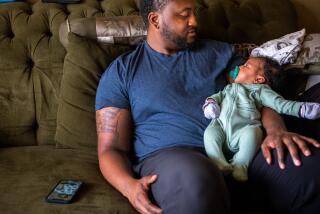The unexpected aches and pains of parenthood
Erin Brady thought it was no big deal to carry her then-13-month-old son, Kyle, across a parking lot so she could show him off to a friend.
But the next morning, her back hurt so much that the 37-year-old stay-at-home mother had to make an emergency visit to a chiropractor. Her husband, a computer programmer, ended up taking two days off from work to care for Kyle while his wife lay immobilized.
“I know now not to push myself,” said Brady, of Owings Mills, Md., who is pregnant with the couple’s second child.
Back pain is an unexpected problem for many parents -- especially the growing number who are waiting longer to start their families.
Wonder how a mom or dad can get hurt just taking care of children? Let us count the ways:
Bending over to change diapers, putting kids in the car seat, in the stroller, in the high chair. Folding the stroller and hoisting it into the minivan. Twisting to separate tussling siblings. Giving piggyback rides. Stepping over the safety gate while carrying children or groceries. Nursing the baby on one side, day after day. Lifting the toddler out of his crib, carrying him on one hip while you twist to stir the spaghetti sauce. Hoisting the first-grader out of the car to keep from waking her up. Practicing baseball in the backyard with your Little Leaguer.
“There are movements people make every day with a child, with an infant, that you don’t think about, but done over and over again can cause overuse injuries,” said Alan Sokoloff, a Glen Burnie, Md., chiropractor.
Larger babies and the stress they cause to women’s bodies during birth also contribute to the problem, said Hollis Herman, a physical therapist and coauthor of “How to Raise Children Without Breaking Your Back.”
Statistics on the prevalence of parental injuries are hard to come by. But chiropractors, orthopedic surgeons and physical therapists say problems are common as the age of parents creeps up.
While the birth rate declined from 1990 to 2002 for women younger than 30, it rose during the same period for older women -- from 80.8 to 91.5 births per 1,000 women ages 30 to 34, and 31.7 to 41.4 births for those ages 35 to 39, according to the National Center for Health Statistics.
Dr. Nicholas DiNubile, a Philadelphia-area orthopedic surgeon who specializes in the problems of baby boomers, said that for many in their late 30s and 40s, parenthood could aggravate dormant problems.
“You’re bent over and you’re moving in ways you shouldn’t, because you’re chasing someone around who’s 2 feet tall,” said the 51-year-old father, whose children are 3 and 7. “You never do it with proper biomechanics.”
The problems often start during pregnancy, when many women experience carpal tunnel syndrome and sciatica. Hormones weaken the joints and stretch ligaments. Weight gain throws the body off balance, stretches out the abdomen and weakens the back muscles.
Prolonged bed rest, often prescribed by doctors concerned about complications of pregnancy, also can reduce muscle strength.
“The pregnancy and all the missteps [women] can take during the pregnancy is all but inviting a problem in the lower back,” said Jerome McAndrews, a former president of the Assn. of Chiropractic Colleges and spokesman for the American Chiropractic Assn. “The older the woman is -- and we don’t have a study on this -- I would say the more likely it is she’s going to have problems.”
Susannah Wolf, 35, a stay-at-home mother, noticed pain in both wrists starting when her son, Samuel, was 5 months old. She’s twice gotten cortisone shots to relieve the symptoms. Doctors told her that she has De Quervain’s syndrome -- also known as “washerwoman’s sprain” -- and that it often strikes new mothers.
Before she knew what was wrong, Wolf said, “I was really scared that I wasn’t going to be able to care for him.” She has since tried to remember to support Samuel, now 14 months, from underneath to ease the stress on her wrists.
Jan Howells, a physical therapist, said she frequently saw parents carrying infants in basket carriers that snap into car-seat bases -- a move that throws off the center of gravity and strains elbows and wrists.
Howells runs a “therapeutic Pilates” class for new mothers and mothers-to-be to help prevent such injuries.
Sometimes small changes -- such as being aware of posture -- can go a long way, Howells said.
Soon after he became a father at age 41, Jonathan Lowenberg knew he’d have to be careful with his kids to avoid getting hurt. He tries to remember to lift properly, and now enlists his son and daughter, 11 and 9, to help him move things.
“Probably the worst that ever happened was I had to go lay down on a heating pad,” said Lowenberg, now 52. “It just came with the territory. I knew that, starting a little older, I was going to be more subject to that sort of thing -- aches and pains.”
There are products that help parents carry babies on their chests or backs -- but some parents quickly stop using them, either because a child’s become too heavy or because he or she dislikes being confined.
And when it comes to responding to their children, even well-educated parents can ignore their better instincts.
Chiropractor McAndrews said that while a mother or father might think to lift from the legs when picking up a heavy box, he or she might not take the same care when comforting a crying toddler. “It’s instantaneous, the way they deal with the child,” he said.
Robin Rose-Samuels, 42, knows the dilemma. She’s had longtime back problems that have flared up since the births of her boys, now 4 and 6. The boys don’t need to be lifted much anymore, but they do have a beloved bedtime ritual -- each is carried to his bunk by a parent.
Recently, after Rose-Samuels had a physical therapy treatment, her 51-year-old husband tried to keep up the routine by hoisting both boys. He promptly threw out his back.
“He thought he could be Superdad,” she said.
Even physical therapist Howells acknowledges that she has, at times, ignored her own advice and lugged her 6-month-old daughter in the basket carrier.
“It’s OK to do some of these naughty things,” she said, “as long as you don’t do them constantly.”
*
(BEGIN TEXT OF INFOBOX)
Injury-free parenting
With a little forethought, parents can reduce the likelihood of being injured by raising kids. Here are some tips from the book “How to Raise Children Without Breaking Your Back” by Alex Pirie and Hollis Herman:
Alternate the side on which you carry and nurse children whenever possible.
Slow down your movements and think in steps. For example, lift the child and then turn.
Your little one is pitching a fit in public? First, take a deep breath -- tension in the body can make an injury more likely. Then kneel or squat at the child’s level to soothe him or her. If you have to scoop the child up quickly, you’ll be in a better lifting position.
Take the time to open your child-safety gate. Stepping over it can be hazardous, not only because of tripping but also because it can injure the back.
Although it’s convenient, try not to carry your baby in a portable car seat. If you must, alternate sides frequently.
Talk to and hug your child as you lift -- you’ll naturally exhale and bring the child’s weight closer to your body.


